The preface to the Greek Textus Receptus (TR) most commonly used today has been neglected and forgotten. The TR of F. H. A. Scrivener (1813–1891), originally titled, The New Testament in Greek According to the Text Followed in the Authorised Version, Together With The Variations Adopted In The Revised Version contained an original preface which may be read in full here or below. The preface appears to have been printed on Christmas, 1880, though not published till 1881. The text was first printed in 1881, 1883, 1884, 1886, and 1890, with a second edition printed in 1894, 1902, and 1908. Where did this text come from and what was it all about?
[Editor’s note – some updated material, images, and data, were added below updating and expanding the initial post after I obtained a copy of the 2022 TBS TR.]
Creating the Text
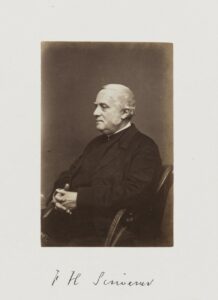
F.H.A Scrivener, By Samuel Alexander Walker, published 1874; Licensed for use from the National Portrait Gallery
This Greek text was first printed in 1881 by Cambridge University Press as a companion volume to the 1881 Revised Version, the official revision of the 1611 KJB or Authorized Version (AV). The Revision Company was instructed by Convocation in their General Principles (VIII.4) that “the text to be adopted be that for which the evidence is decidedly preponderating: and that when the text so adopted differs from that from which the Authorized Version was made, the alteration to be indicated in the margin” (Cadwallader, pg. 216). The company tasked Scrivener to “make a list of those places in which the original text approved by the Company differs from the text presumed to be used by the translators of the common version” (CUL MS Add. 6935, f. 34, cited in Cadwallader pg. 91 f.n.13). Scrivener headed the committee on marginalia for the RV and keeping this list was an “explicit task given to him alone by the Company” (Cadwallader pg. 91).
In order to comply with their instructions, as Palmer recorded, “Dr. Scrivener kept the record for the New Testament Revision Company of the readings which it adopted, and prepared the list of these readings which was communicated to the University Presses” (pg. viii). It was concluded that including all these variant readings “would often crowd and obscure the margin of the Revised Version” (see preface below). The University Presses also ended up not including the vast wealth of marginal scripture cross-references which Scrivener compiled, as these too would crowd the margins. See examples of the originally planned crowded marginal references with Scrivener’s numerous notes in page proofs of an early revision dated 1879, BL shelf-mark General Reference Collection 3054.c.1. The Syndics of CUP decided that the best way to comply with Convocation’s instructions was to separately print the continuous Greek text of the AV and set out in the apparatus at the foot of the page alternative readings adopted in the RV.

I John 4:18-5:9 in the 1881 Scrivener TR, bolding textual variants from the 1881 RV which are noted in an apparatus
Scrivener was chosen to edit this text. He couldn’t simply reprint the Greek text of the AV, because the text created by the KJB Translators’ textual choices had never actually been printed. He thus reverse-engineered the Greek text behind the AV. He started with Beza’s Greek NT as a base (the text they had most closely followed), and when the AV disagreed with Beza, substituted whichever form of the antecedent printed Greek texts they appeared to have followed. He then noted at the foot of the page every place where the RV committee made a different textual choice than had been made by the AV committee, causing a difference between their Greek texts, placing the relevant variant in thicker type in the text. The margins of essentially every single page of this TR were thus chock full of text-critical material, and this material was the express purpose of its existence. An example page showing I John 5:7 in thicker type can be seen in a Harvard copy here, or at the right.
Fellow Reviser Edwin Palmer followed a similar but reversed procedure in printing the Greek text of the RV in 1882 for Oxford University Press. He used Scrivener’s critical edition of Stephanus (see below) as a base and altered the text to match the Greek basis of the RV in every place the Revisers had disagreed with the textual basis of the KJB NT, listing in the apparatus:
- Readings of the AV matching Stephanus 1550 where revised by the RV
- Readings of Stephanus 1550 not followed in the AV
- Alternate readings included in the margins of the RV
Cadwallader seems to mistakenly think that Scrivener’s and Palmer’s were the same text, simply printed by the two different presses (pg. 91, f.n. 13), missing that one was the text of the KJB, the other the text of the RV. Palmer’s text of the RV was proof-read and approved by Scrivener, for which Palmer expressed gratefulness (pg. vii-viii).
Because the Translators of the AV sometimes rendered into English (or left in unrevised English) wording that had its source in the Latin Vulgate instead of any then-known Greek, and because Scrivener refused in such places to back-translate Latin or English into Greek, even Scrivener’s text does not exactly represent the text behind the AV. It is, however, the closest to it that has ever been printed.
The Preface Lost
Unfortunately, TBS later reprinted the text itself, from the 1894 edition, with a different (shortened) title. Even when citing the fuller title in a new preface they omitted the latter part explaining that it was printed “Together With The Variations Adopted In The Revised Version.” They omitted mention of its 1881 creation date, citing only 1894 and 1902 editions. These choices obscure its connection to the 1881 RV so clearly expressed in the original title. They entirely omitted Scrivener’s preface explaining the origins of the work. They omitted the apparatus which was the express purpose of the creation of the text; a purpose expressed in the very title of the original work. These are strange editorial choices indeed, which blur the original origins of this text and its connection to the 1881 RV. In a concluding statement in a new 2-page preface the unnamed editors explain:
The present edition of the Textus Receptus underlying the English Authorized Version of 1611 follows the text of Beza’s 1598 edition as the primary authority, and corresponds with “The New Testament in Greek According to the Text Followed in the Authorised Version,” edited by F. H. A. Scrivener, M.A., D.C.L., LL.D., and published by Cambridge University Press, 1894 and 1902.
This was the edition sold and used as the base text at my alma mater which professes that this text preserves, “the very words [God] inspired.” This has the unfortunate result of insulating students from reading the preface. The profession is more difficult to maintain when the full history and late Victorian origins of this text as revealed in the preface are known. Grange Press has printed a beautiful new edition of Scrivener’s text as a reader’s edition which will help students read the text. Sadly, rather than include Scrivener’s original preface they translate the preface to the much earlier 1633 edition of the Elzevir brothers.
A new edition in a beautiful calfskin leather (2022) has been produced by TBS with slightly improved prelims from their older editions, correcting some of the problems in the above paragraphs. For example, it now acknowledges the 1881 date of the original printing. A footnote has been added to the statement cited above now citing the full title. This is something for which all should be grateful. Strangely, this footnote cites the title of the 1902 edition in a format which seems to confuse the data from the CUL catalogue. The particular copy being referred to appears to be CUL BSS.130.F02. The “Uniform Title” in the catalogue for this copy (a technical entry which helps librarians locate an item across various catalogues) in the CUL catalogue, is “Bible. New Testament. Greek. 1902.” This is the title cited in the new footnote in the TBS edition, instead of the full title, which is presented as the title in the catalogue entry which also includes mention of Scrivener as editor. More strangely the format of the new TBS footnote cites both Scrivener and Beza as editors, perhaps misreading the “other entry” section of the CUL catalogue which has both for reference purposes, a choice that suggests a more ancient pedigree than the text actually has.
Oddities continue. The updated TBS preface now concludes not with the statement above, but with a new explanation (rationale?) for printing the text in its current form. The comments are worth citing in full, picking up after the mention of the 1894 and 1902 editions retained from the prior TBS edition (pg. iii):
These two editions differed from the 1881 Scrivener edition in two main ways—any differences that Scrivener purportedly identified Beza’s 1598 edition (and related to the other corresponding Greek editions and available versions, such as Stephanus 1546, in the Appendix found in both Cambridge editions) are not indicated in the actual text and thus it is not intended for textual study. Furthermore, the differences with the Greek underlying the Revised English Version of were not marked in bold type. This clean text (with any spaced type removed in the TBS edition) fits with the purpose of the Trinitarian Bible Society edition: to provide an edition of the Textus Receptus for use by translators, ministers, Bible students, and Christians around the world, rather than a textual study or comparison to the Revised Version or any other version.
A reader could be forgiven for not fully grasping what is said here. First, a minor point – the 1894 and 1902 printings of Scrivener’s AV text are not “two editions” but two identical printings of the same edition. The same CUL catalogue entry from which the TBS editors have apparently taken the Uniform Title and Beza as an editor describes the 1902 edition as:
An exact reprint of the edition of 1894, which was a revision of the Greek Testament with the same title published by Scrivener in 1881 (D. & M. 4915), in which he attempted to present the Greek text (in the main that of Beza) which presumably underlies the A.V. of 1611, and to record at the foot of each page the variations adopted by the Revisers of the Revised English Bible of 1881.
Second, the “two main ways” these two printings are said to differ from the 1881 need explanation. The 1894 edition added a note, printed Christmas 1893, which can be read in full at the bottom of this post, explaining two differences in this second edition. The first main difference is that in the first edition of Scrivener’s TR (1881 and later printings) the places where the Greek text of the KJB differed from that of Beza’s 1598 edition were marked out in two ways:
- An appendix listed each of them, material originally compiled for Scrivener’s work on the 1873 CPB (see below) and sketched out there in parts 1 and 2 of Appendix E. Notable differences reveal continuing work. (The entry on I John 2:23 matures for example.)
- In the text itself wherever one of these differences occurred, an asterisk * was added in the text itself.
In the 1894 edition (reprinted 1902, 1908) the asterisks were removed. The appendix was retained. However, TBS imparts a motive to this change distinctly different from that actually cited by the editors of the 1894 text. For TBS, this change means that this new edition “is not intended for textual study.” But quite the contrary, the original editors explained that this change was made because it was redundant. It was not “thought necessary” to retain the asterisks, because, “the Appendix, which is retained, sufficiently [shows] the passages in question.”
The second main difference between the two editions of Scrivener is that in the first edition (1881) textual variants between the KJB and ERV are marked out in two ways:
- An apparatus at the bottom of the page list each difference for that page.
- Each reading was placed in “thicker type” (essentially bold) within the text itself.
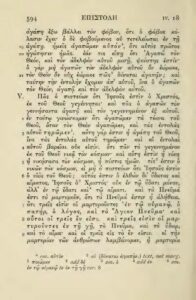
I John 4:18-5:9 in the 1894 Scrivener TR. Bolding has been replaced by spaced type which signals textual variants from the 1881 RV which are also noted in the apparatus.
In the second edition, the apparatus remains the same, untouched. In the text itself, “in lieu of using thicker type to indicate readings which have not been used by the Revisers,” the editors adopted “spaced type.” That is, within a word that is a variant from KJB to RV, there is now an added spacing between letters. This has the effect of still visually marking the variants within the text but more subtlely. This editorial move made sense. Bold type is visually jarring, and there is no need for it when a footnote in the text already links to a marginal note explaining each variant. Signaling the variant in the text itself with spaced text instead of thicker text removes the redundancy. These changes can be seen by comparing the page above from the 1881 with the same page at the left from the 1894 edition.
TBS however has, I think quite mistakenly, interpreted this as an attempt by Cambridge to print a “clean text,” which they claim was “not intended for textual study” and which thus “fits with the purpose of the Trinitarian Bible Society” to print a text “for use by translators, ministers, Bible students, and Christians around the world, rather than a textual study or comparison to the Revised Version or any other version.” That this is the purpose of the TBS text is obvious, and it is a noble goal. I am grateful they are filling it. However, that this was not the purpose of the 1894 CUP text is just as obvious. The appendix showing differences from Beza still remains. More importantly, every variation from the RV is still indicated, the stated purpose of this text, expressed in the very title, in a marginal apparatus, and even in spaced type representing every variant in the text itself. Most important, the original preface to the work, explaining its purpose, entirely omitted from the TBS editions, is still present in every edition of Scrivener’s text published by CUP.
Perhaps the most grievous mistake of the new TBS preface though is in an added section tracing the history of textual criticism from the Tudor to the Victorian eras. I cite one paragraph (pg. ii), which provides an example of the kind of misrepresentation of Scrivener I take up in the next section:
The editions of Stephanus, Beza, and the Elzevirs all present substantially the same text; the variations are not of great significance and rarely affect the sense. However, in the nineteenth century numerous scholars set out to produce Greek texts which would reflect new principles of textual criticism. The resultant texts differed increasingly from the long-accepted texts of previous centuries and resulted in a new English Version, the English Revised Version of 1881 (American version published 1901). Late in the century F. H. A. Scrivener went against this trend and in 1881 published an edition of the Greek using the earlier printed Greek texts with reference to the 1611 English Authorized Version.
Scrivener Misunderstood
Advocates for the KJB or TR have sometimes grossly misunderstood both Scrivener’s beliefs and his intentions in creating this text (quite possibly precisely because they lack the original preface to the text they use and endorse). R. B. Ouellette, for example, says of Hort and Westcott, in a blatant attempt to impugn their motives, “Men on their own committee such as Scrivener and Ellicott saw the superiority of the Greek Textus Receptus and questioned Hort’s true intentions. Scrivener, after the revision, edited his own Textus Receptus, choosing to have his name associated with what the churches recognized through the centuries rather than the apostasy associated with the new text” (Ouelette, R.B., A More Sure Word: Which Bible Can You Trust?, pg. 108). Hardly a phrase in that statement is true. Scrivener highly respected Westcott and Hort, though he didn’t fully agree with their theories. He never once questioned their integrity or their motives. Indeed, in the third edition of his Intro to textual criticism (see below) he explained that he had stated his case against “opponents far my superiors in learning and dialectic power, and for whom, in spite of literary differences, I entertain deep respect and true regard.” He never defend the TR or the KJV as inerrant, having pointed out its manifest errors as early as 1845 (see below). Most importantly, he didn’t publish his TR because he thought it represented the original text. Nor did he have any intention in publishing it to disassociate himself from the RV. Indeed, his text was published as a companion volume to the RV. (The misappropriation of Ellicott in the above statement is even more egregious.)
Ouellette and others who latch onto Scrivener as a champion of the TR are spreading misinformation and historical revisionism, as Dan Wallace points out here. See a response of Maurice Robinson to Wallace’s article here, clarifying that it is primarily KJV/TR advocates, rather than Majority Text advocates, who are guilty of spreading this revisionist history. Though we should note that even as eminent a textual critic as D.C. Parker, in the ODNB entry which he edited (revising an older entry), writes what is at best imprecise, claiming that Scrivener, “inclined towards J. W. Burgon against B. F. Westcott and F. J. A. Hort in favouring the textus receptus.”
Perhaps no group has a corner on the market of misunderstanding or misrepresenting Scrivener. Indeed, misrepresentation and misappropriation of Scrivener began during his own lifetime. Burgon had employed his name, and seems to at times even have “deliberately misapplied” some of Scrivener’s words in his own cause (Cadwallader, pg. 95). Hort, for his part, noted how odd it was that Burgon sought to claim Scrivener. In a letter Hort observed, “Burgon’s language about Scrivener is very strange, but cannot be taken as evidence in the teeth of Scrivener’s own writings, and especially the progress they have exhibited” (CUL MS Add. 6597, fol. 189, as cited in Cadwallader, pg. 95 f.n. 39). Though we should note that contemporary appropriation of Scrivener by Burgon is far more plausible than modern appropriation of Scrivener as defending the inerrancy of his own TR.
Scrivener the Textual Critic
The Stephanus Critical TR
Scrivener early on printed a critical edition of Stephanus’ TR, which reprinted the 1550 text of Stephanus in the text, while including an apparatus noting variants, not in Greek manuscripts, but from several major printed Greek texts for comparison. He continued to update this text throughout his career. Darlow-Moule considered this text to have four recensions:
- The first in 1859, (reprinted in 1860, 1861, 1862, 1864, 1865, 1867, 1868, 1870, 1871, 1872, 1873, and 1875);
- The second in 1876 (reprinted in 1877, 1878, 1879, 1881, 1883, 1884, and 1886), which “completed the list of Tregelles’ variants, and adapted Tischendorf’s variants to that editor’s edition of 1869, 72;”
- The third in 1886, in which he “added the variants of Westcott and Hort and of the text supposed to underlie the English R. V” (reprinted in 1887, 1891, 1900 and 1902);
- The fourth in 1906, “A careful revision,” posthumously prepared by E. Nestle.
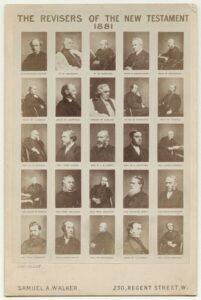
The Revisers of the New Testament 1881; By and after Samuel Alexander Walker, 1881 (early-mid 1870s); Licensed for use from the National Portrait Gallery
This critical edition of Stephanus, Cadwallader notes, is what the Revision Committee did their own work from, “the starting point for argument, assessment, and decision,” the “base from which the Company began their work to establish the Greek text that they would adopt for the sake of English revision” (pg. 101), and “the primary point of reference for the establishment of the Greek text” (pg. 102). They compared copies of an early 1871 private printing of the Westcott-Hort text (pg. 104-105) and departed from Stephanus at numerous points. Contrary to what is sometimes claimed these “printed copies of Westcott and Hort’s Greek New Testament did not supplant Scrivener’s edition of Stephanus to become the text from which the Revisers worked” (Cadwallader, pg. 103). Indeed, as early as Ellicott and Palmer’s response to the misguided claims of Burgon that the Revisers had been wholly swayed by Westcott and Hort, they pointed out that the Revisers’ text only followed Westcott and Hort alone (that is, against all other printed Greek texts) in 64 places (pg. 41).
Early Textual Work
When Convocation issued its ruling to revise the KJB Scrivener had already labored for many years as an eminent textual critic. Some of his early textual works were:
- A Full and Exact Collation of about Twenty Greek Manuscripts of the Holy Gospels (Hitherto Unexamined), in 1853
- An Exact Transcript of the Codex Augiensis (with collations of fifty other manuscripts) was published in 1859
- Contributions to the Criticism of the Greek New Testament, 1859 (the intro to the Augiensis transcript printed separately)
- A collation of Codex Sinaiticus in Wordsworth’s New Testament (1856; 1859)
- A full collation of Codex Sinaiticus against the TR in 1864
- Bezae Codex Cantabrigiensis, being an Exact Copy, in Ordinary Type, of the Celebrated Uncial Graeco-Latin Manuscript of the Four Gospels and Acts of the Apostles … Edited with a Critical introduction, Annotations, and Facsimiles, in 1864
Later contributions include works like his slender, Codex S. Ceaddae Latinus (1887) comparing Codex L and Amiatinus in Matt. 1-Luke 3, his Adversaria Critica Sacra published posthumously in 1893 (Cambridge reprint here), and works with a less textual focus, like his Index to the Bishop of Lincoln’s Commentary (1871; 1876). His biographers note that:
Scrivener’s achievement did not go unnoticed: on 3 January 1872, he was granted a civil-list pension of £100 in recognition of his services in connection with biblical criticism and in aid of the publication of his works. He was created LLD of St Andrews in the same year, and DCL of Oxford in 1876. He took an important part in the revision of the English version of the New Testament (1870–82).
In 1876 he was made vicar of Hendon. The strain of his textual work (primarily on the 3rd edition of his Introduction) led to a paralytic stroke in 1884, though he pressed on in his labors, expanding material for the 4th edition. He died on 26 October 1891.
Career Focus on the KJB
He had from the very beginning of his career paid special attention to the KJB. His very first publication, A Supplement to the Authorized English Version (see BL copy here) in 1845 centered around it. It noted his love and reverence for the KJB and used the Gospel of Matthew as a test case to set out many places it needed updating and correcting due to:
- Textual errors (“errors of criticism”)
- Translation errors (“errors of interpretation”)
- Archaic language (“errors of expression”)
“It is the design of the present work to collect and review those passages of our authorized version of the New Testament, which a diligent collation with the original may show to be inaccurate or obscure…” he explained of the volume (pg. 3). His A Plain Introduction To The Criticism Of The New Testament became a standard work on textual criticism that heavily influenced the members of the revision committee, going through four major editions:
- First, 1861, (or here, Cambridge reprint here)
- Second, 1874
- Third, 1883, with a dedication to Edward Benson, newly elected archbishop (Googlebooks)
- Fourth, posthumously expanded/revised by Edward Miller, 1894(Vol. I here, Vol. II here)
Note that Miller, I suspect, slightly “Burgonized” the text in the fourth edition at points. As an example note the almost complete reversal (in the 4th ed., Vol. II, chapter VI) of the caution Scrivener retained almost verbatim about patristic citations in the 1st-3rd editions, explained as Miller’s own interpretive addition in a footnote on pg. 167.
Cambridge asked Scrivener to edit and publish a new edition of the Authorized Version (correspondence between him and the press remains here) which would restore its text to a more accurate form (accurate here meaning, closer to the form actually printed in 1611 than the wildly divergent printings that had come to be common) and make the text more readable and legible (set out in paragraphs, with modernized spelling, etc.). This volume was published in 1873 as The Cambridge Paragraph Bible, with an extensive introduction by Scrivener.
In 1875, mid-way through the course of working on the Revision, he published Six Lectures on the Text of the New Testament, a layman’s introduction to the principles of textual criticism. Westcott and Hort had apparently kindly given him a copy of their as yet unpublished Greek NT and permission to use it in crafting this introduction (Cadwallader pg. 93).
His introduction to the CPB was later (in 1884, and again in 1910) expanded into a full book specifically on the history and origins of the text of the Authorized Version, titled, The Authorized Edition of the English Bible (1611), Its Subsequent Reprints And Modern Representatives. The official reprint by Cambridge (which has oddly changed the title), is available here. He thus became something of the recognized expert of the day on the history and text of the AV, and especially of its NT.
Scrivener edited a triglot edition of the AV, its Greek text, and the RV, here (preface pg. xxiii-xxvi). The official reprint by Cambridge of the 1881 first edition of the AV Greek text may be purchased here (Cambridge) or here (Amazon). The preface section may be downloaded free from Cambridge here, included in its entirety below. The 2008 Logos edition may be purchased here, which, as I understand it, has been morphologically tagged by Maurice Robison.
View of the KJB and its Greek Text
Naturally, when the time came to edit and publish the Greek text behind the KJB NT in conjunction with the RV, Scrivener was the clear choice. “If anyone was familiar with the detail of the status quo for the AV, Scrivener was” Cadwallader explains (pg. 90). We should note that we thus have the Revisers and their integrity to thank for the printing of the Greek text behind the KJB NT. His own principles of textual criticism (which were somewhere between those of J.W. Burgon and Westcott/Hort; closer to Burgon of the two, by his own account) are clearly set out in his Introduction. Mark Ward in a fascinating lecture, traces Scrivener’s treatment of some famous variants using his Six Lectures as a guide.
Contrary to claims sometimes made by those who want to claim him as defending the TR as inerrant, his published Greek text does not represent his final judgment about the original text of the NT, but is, as he explains in its Preface, his attempt to set out the Greek text that underlies the 1611 Authorized Version. He had from the beginning to the end of his career pointed out, with a respectful and reverent attitude, the imperfections of the text of the AV and the need for continuing textual criticism to restore the text to its original purity. As Maurice Robinson wisely cautions: “Scrivener must be examined from a perspective which takes the entire scope of his writings into consideration. Further, one must consider the specific and overall context applicable to any excerpted quotation. Finally, one must be ever conscious of changes in opinion reflected in Scrivener’s writings, particularly with his most recent works.” That full examination of his method is beyond the scope of this post. Still, one can see in some representative statements below several notable factors:
- Deep respect for Byzantine manuscripts/disapproval of disregarding them
- A general appreciation for the KJB and TR editions
- A clear sense that neither the TR nor KJB were perfect; both needed correction and revision
- Textual criticism’s value for purifying the text and strengthening confidence in scripture
The leading principles by which my criticisms are directed may readily be gathered from the foregoing remarks. I would adhere as much as possible to the text of the editions of Stephens, Beza and the Elzevirs; not indeed because it is the received text (as Lachmann so unfairly insinuates); but because I believe it to bear, on the whole, a close resemblance to the best manuscripts, which have been used by the Greek Church from the earliest ages. The schemes both of Griesbach and of Lachmann I feel bound to reject, since their direct tendency is to overthrow the testimony of the vast majority of our critical authorities, on grounds too precarious to admit of satisfactory defence. By conceding some weight to internal evidence, and by following out Scholz’s hypothesis more consistently than he has done for himself, we may hope to purge the received text of its grosser corruptions, and to approach more nearly to the Apostolic autographs than any of the illustrious scholars whose attempts have passed under our notice.
– Scrivener, A Supplement, pg. 31-32, 1845
I for one see nothing in the history or sources of the received text to entitle it, of itself, to peculiar deference. I esteem it so far as it represents the readings best supported by documentary evidence, and no further: if in my judgment the Elzevir text approaches nearer on the whole to the sacred autographs than that formed by Tischendorf, it is only because I believe that it is better attested to by the very witnesses to whom Tischendorf himself appeals; the MSS., the versions, the Primitive Fathers. I enquire not whether this general purity (for it is but general) arises from chance, or editorial skill, or (as some have piously thought) from Providential arrangement: I am content to deal with it as a fact…
– Scrivener, Augiensis, vi, 1859, emphasis original.
[The abundance of Greek NT Manuscripts] present us with a vast and almost inexhaustible supply of materials for tracing the history, and upholding (at least within certain limits) the purity of the sacred text: every copy, if used diligently and with judgement, will contribute somewhat to these ends. So far is the copiousness of our stores from causing doubt or perplexity to the genuine student of Holy Scripture, that it leads him to recognize the more fully its general integrity in the midst of partial variation….
The design of the science of Textual criticism, as applied to the Greek New Testament, will now be readily understood. By collecting and comparing and weighing the variations of the text to which we have access, it aims at bringing back that text, so far as may be, to the condition in which it stood in the sacred autographs; at removing all spurious additions, if such be found in our present printed copies; at restoring whatsoever may have been lost or corrupted or accidentally changed in the lapse of eighteen hundred years….Those who believe the study of the Scriptures to be alike their duty and privilege, will surely grudge no pains when called upon to separate the pure gold of God’s word from the dross which has mingled with it through the accretions of so many centuries.
– Scrivener, A Plain Introduction, pg. 5-7, 1894 edition
Now it were unreasonable to suppose, that if our authorised version is so great an improvement on all that went before it, during the short space of eighty years, the current of improvement is here to stop, and that no blemishes remain for future students to detect and remove. More than two centuries have passed since that version (or, to speak more correctly, revision of former versions) was executed, and they have been centuries of great and rapid improvement in every branch of knowledge and science….In [the KJB Translators’ time] Scriptural criticism was but in its infancy. Few manuscripts had been collated in order to settle the original text; the Greek language, in particular, was studied rather extensively than accurately; the peculiar style of the writers of the New Testament was little understood.
– Scrivener, A Supplement, pg. 2-3, 1845
This post however is about his neglected preface to the KJB NT. This preface, explaining the origins of his edition of the text of the KJB NT (with some highlights pulled out, and images added), follows in full;
Scrivener’s Preface To The TR
First Edition 1881
Reprinted 1881 (twice), 1883, 1884, 1886, 1890, 1894, 1908.
PREFACE
The special design of this volume is to place clearly before the reader the variations from the Greek text represented by the Authorised Version of the New Testament which have been embodied in the Revised Version. One of the Rules laid down for the guidance of the Revisers by a Committee appointed by the Convocation of Canterbury was to the effect “that, when the Text adoped differs from that from which the Authorised Version was made, the alteration be indicated in the margin.” As it was found that a literal observance of this direction would often crowd and obscure the margin of the Revised Version, the Revisers judged that its purpose might be better carried out in another manner. They therefore communicated to the Oxford and Cambridge University Presses a full and carefully corrected list of the readings adopted which are at variance with the readings “presumed to underlie the Authorised Version,” in order that they might be published independently in some shape or other. The University Presses have accordingly undertaken to print them in connexion with complete Greek texts of the New Testament. The responsibility of the Revisers does not of course extend beyond the list which they have furnished.
The form here chosen has been thought by the Syndics of the Cambridge University Press to be at once the most convenient in itself, and the best fitted for giving a true representation of the Revisers’ work. In their Preface the Revisers explain that it did not fall within their province to construct a continuous and complete Greek text. Wherever a variation in the Greek was of such a nature that it could properly affect the English rendering, they had to decide between the competing readings: but in most other cases they refrained from spending time on work not needed for the purposes of an English translation. It was therefore impossible to print a continuous Greek text which should include the readings certified as adopted by the Revisers, without borrowing all the intervening portions from some printed text which had not undergone their revision, and in which, to judge by analogy, they would doubtless have found many readings to disapprove. It is true that all variations in this unrevised part of the text must from the nature of the case be comparatively unimportant: but they include many differences of order and grammatical form expressive of shades and modifications of meaning which no careful reader would neglect in studying the Greek original. The Cambridge Press has therefore judged it best to set the readings actually adopted by the Revisers at the foot of the page, and to keep the continuous text consistent throughout by making it so far as was possible uniformly representative of the Authorised Version. The publication of an edition formed on this plan appeared to be all the more desirable, inasmuch as the Authorised Version was not a translation of any one Greek text then in existence, and no Greek text intended to reproduce in any way the original of the Authorised Version has ever been printed.
“…the Authorised Version was not a translation of any one Greek text then in existence, and no Greek text intended to reproduce in any way the original of the Authorised Version has ever been printed.”
– F. H. A. Scrivener
In considering what text had the best right to be regarded as “the text presumed to underlie the Authorised Version,” it was necessary to take into account the composite nature of the Authorised Version, as due to successive revisions of Tyndale’s translation. Tyndale himself followed the second and third editions of Erasmus’s Greek text (1519, 1522). In the revisions of his translation previous to 1611 a partial use was made of other texts; of which ultimately the most influential were the various editions of Beza from 1560 to 1598, if indeed his Latin version of 1556 should not be included. Between 1598 and 1611 no important edition appeared; so that Beza’s fifth and last text of 1598 was more likely than any other to be in the hands of King James’s revisers, and to be accepted by them as the best standard within their reach. It is moreover found on comparison to agree more closely with the Authorised Version than any other Greek text; and accordingly it has been adopted by the Cambridge Press as the primary authority. There are however many places in which the Authorised Version is at variance with Beza’s text; chiefly because it retains language inherited from Tyndale or his successors, which had been founded on the text of other Greek editions. In these cases it is often doubtful how far the revisers of 1611 deliberately preferred a different Greek reading; for their attention was not specially directed to textual variations, and they might not have thought it necessary to weed out every rendering inconsistent with Beza’s text, which might linger among the older and unchanged portions of the version. On the other hand some of the readings followed, though discrepant from Beza’s text, may have seemed to be in a manner sanctioned by him as he had spoken favourably of them in his notes; and others may have been adopted on independent grounds. These uncertainties do not however affect the present edition, in which the different elements that actually make up the Greek basis of the Authorised Version have an equal right to find a place. Wherever therefore the Authorised renderings agree with other Greek readings which might naturally be known through printed editions to the revisers of 1611 or their predecessors, Beza’s reading has been displaced from the text in favour of the more truly representative reading, the variation form Beza being indicated *. It was manifestly necessary to accept only Greek authority, though in some places the Authorised version corresponds but loosely with any form of the Greek original, while it exactly follows the Latin Vulgate. All variations from Beza’s text of 1598, in number about 190, are set down in an appendix at the end of the volume, together with the authorities on which they repsectively rest.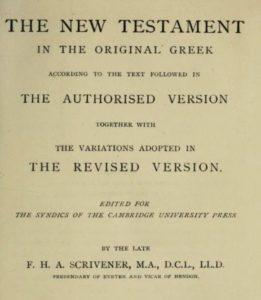
“It was manifestly necessary to accept only Greek authority, though in some places the Authorised version corresponds but loosely with any form of the Greek original, while it exactly follows the Latin Vulgate.”
– F. H. A. Scrivener
Wherever a Greek reading adopted for the Revised Version differs from the presumed Greek original of the Authorised Version, the reading which it is intended to displace is printed in the text in a thicker type, with a numerical reference to the reading substituted by the Revisers, which bears the same numeral at the foot of the pages. Alternative readings are given in the margin by the Revisers in places “in which, for the present, it would not” in their judgement “be safe to accept one reading to the absolute exclusion of others,” provided that the differences seemed to be of sufficient interest or importance to deserve notice. These alternative readings, which are more than 400 in number, are distinguished by the notation Marg. or marg. In the Revised Version itself the marginal notes in which a secondary authority is thus given to readings not adopted in the text almost always take the form of statements of evidence, and the amount of evidence in each instance is to a certain extent specified in general terms. No attempt however has in most cases been made to express differences in the nature or the amount of this authority in the record of marginal readings at the foot of the page. For such details the reader will naturally turn to the margin of the Revised Version itself.
The punctuation has proved a source of much anxiety. The Authorised Version as it was originally printed in 1611, rather than as it appears in any later edition, has been taken as a primary guide. Exact reproduction of the English punctuation in the Greek text was however precluded by the differences of grammatical structure between the two languages. It was moreover desirable to punctuate in a manner not inconsistent with the punctuation of the Reivsed Version, wherever this could be done without inconvenience, as punctuation does not strictly belong to textual variation. Where however the difference of punctuation between the two Versions is incompatible with identical punctuation in the Greek, the stops proper for the Authorised Version are given in the text, with a numerical reference, without change of type, to the other method set forth in the foot-notes. Mere changes in punctuation, not consequent on change of reading, are discriminated from the rest by being set within marks of parenthesis ( ) at the foot of the page. The notes that thus refer exclusively to stops are about 157.
The paragraphs into which the body of the Greek text is here divided are those of the Revised Version, the numerals relating to chapters and verses being banished to the margin. The marks which indicate the beginning of paragraphs in the Authorised Version do not seem to have been inserted with much care, and cease altogether after Acts xx.36: nor would it have been expedient to create paragraphs in accordance with the traditional chapters. Manifest errors of the press, which often occur in Beza’s New Testament of 1598, have been silently corrected. In all other respects not mentioned already that standard has been closely abided by, save only that, in accordance with modern usage, the recitative ὅτι has not been represented as part of the speech or quotation which it introduces, and the aspirated forms αὑτοῦ, αὑτῷ, αὑτόν &c. have been discarded. In a very few words (e.g. μαργαρῖται) the more recent and proper accentuation has been followed. Lastly, where Beza has been inconsistent, the form which appeared the better of the two has been retained consistently: as νεφάλιος not νεφάλεος, οὐκέτι not οὐκ έτι, ἐξαυτῆς not ἐξ αὐτῆς, ἱνα τί not ἵνατί but τὰ νῦν not τανῦν, δὶα παντὸς not διαπαντὸς, τοῦτʼ ἔστι not τουτέστι.
[The Triglot edition adds here – “Inasmuch as the ordinary English subscriptions to the Pauline Epistles have been retained in the Authorised Version, it has been thought necessary to set their Greek originals in the parallel columns, exactly as they stand in Beza’s edition of 1598, although these subscriptions are of late date, of no real authority, and several of them plainly erroneous.”]
[The 1894 adds a Note, “In this edition it has not been thought necessary to indicate variations from Beza by the mark *, the Appendix, which is retained, sufficiently showing the passages in question; moreover in lieu of using thicker type to indicate readings which have not been used by the Revisers, spaced type has been adopted.” Christmas, 1893]
ΠΑΣΑΓΡΑΦΗΘΕΟΠΝΕΥΣΤΟΣΚΑΙΩΦΕΛΙΜΟΣ.
[All Scripture is inspired by God and profitable]
F. H. A. S.
Christmas, 1880.
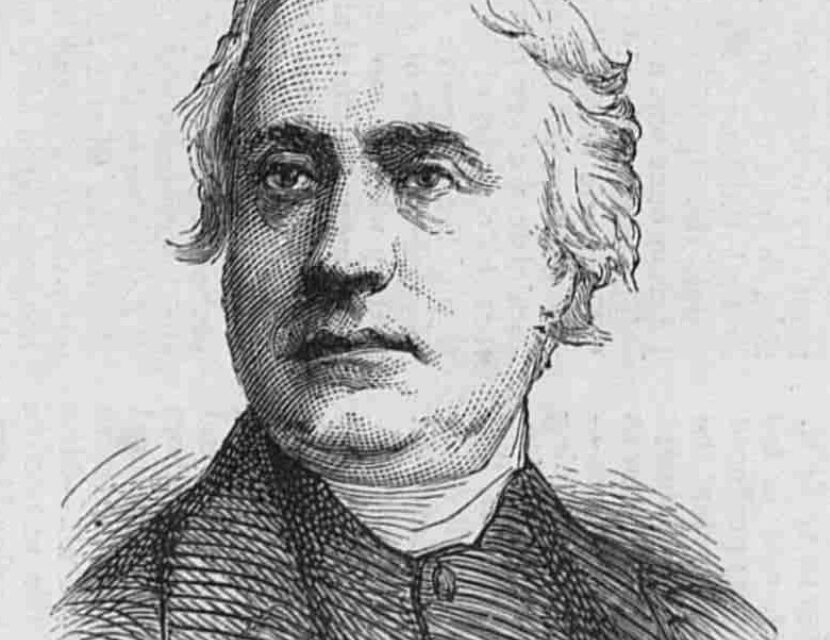
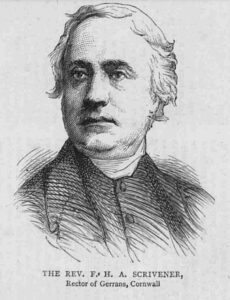
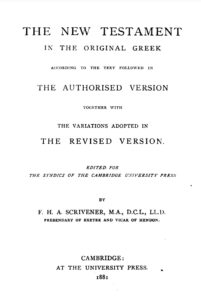
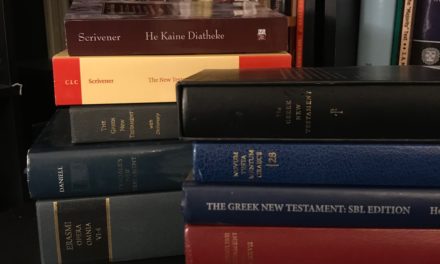

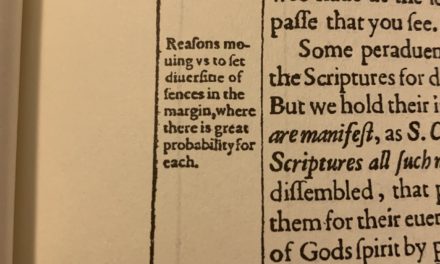

We have an influence in our church from some of the elders teaching Confessional bibliology ! Help !!
We are a reformed Baptist church in Texas .